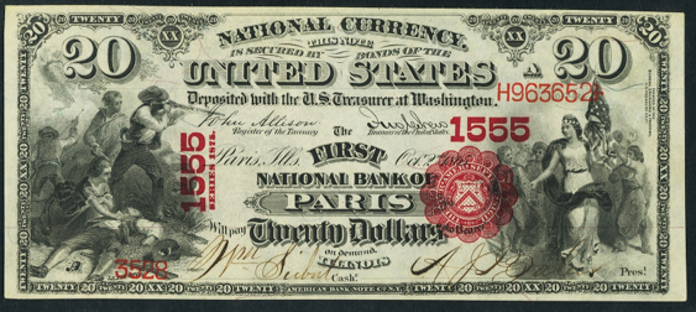Twenty Dollar Notes › Nationals › 1875 Twenty Dollar National Bank Notes › New York Charters › 1875 $20 Cooperstown New York Second National Bank
Get Value Now
| Item | Info |
|---|---|
| Series | 1875 |
| Charter | #223 Second National Bank of Cooperstown, New York |
| Year Chartered | 1864, 503 Banks Chartered |
| City Info | Cooperstown is a village in and county seat of Otsego County, New York, United States. Most of the village lies within the town of Otsego, but some of the eastern part is in the town of Middlefield. Cooperstown is best known as the home of the Farmers' Museum, opened in 1944 on farm land that had once belonged to James Fenimore Cooper. The National Baseball Hall of Fame and Museum, the Fenimore Art Museum, Glimmerglass Opera, and the New York State Historical Association are also based here. Most of the historic pre-1900 core of the village is included in the Cooperstown Historic District, which was listed on the National Register of Historic Places in 1980; its boundaries were increased in 1997 and more contributing properties were identified. Source: Wikipedia |
| Similar Cities | If your note doesn't match try: 1. Cooperstown, New York - First National Bank |
| Seal Varieties | Red with scallops |
| See Also | If your note doesn't match try: 1. 1882 $20 National Bank Notes 2. 1882 $20 Gold Certificate 3. 1875 $20 Legal Tender 4. 1878 $20 Legal Tender |
| Other Info | 1. Value depends on notes known for charter, condition and market demand. |
| Neat Fact | Engraved date is when bank was organized, a 20 or 40 year anniverary of its organization, or date of title change (Kelly, 5th Ed. P 5 & Huntoon 1995). |
No Obligations Offers and Appraisals
Please submit a good photo or scan. It will be identified and evaluated. Understand there may be subtle differences between the image you see above and your note. Signatures, design, markings and note condition will determine the offer price. Notes in Uncirculated or better condition receive the best offers.
Appraisals can be estimated for wholesale and retail prices. Wholesale is what dealers typically pay. Retail is what a collector might pay. Retail is slightly higher in most cases.
Please visit this page for USA Paper Money Reference. Do not treat this page as a reference guide, it is for appraisal and acquisition purposes only.
